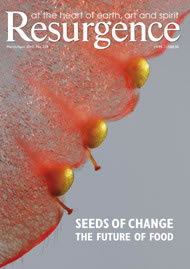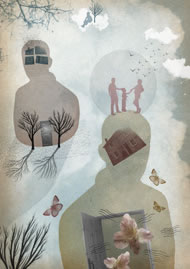I’m talking with Peter Rosser. He turned his back on the Probation Service, fed up with, (old story), the paperwork, but also the absence of informed supervision, and the apparent inability of the Service to enable change in the violent men who were his clients – even those who wanted desperately to escape their propensity for violence.
“So are we living in a violent society?” I ask him. He shakes his head and smiles dryly.
“The Press,” he says, “focuses on President Karzai’s legislation in Afghanistan, which it sees as tantamount to legalising rape in the home, when in Britain, according to The Independent, 300,000 children live with serious domestic violence. We are in denial – and the chief denial is that almost all violence starts at home.”
Ultimately, of course, what is billed as domestic violence is simply another aspect of the violence epidemic in the air that our human society breathes.
“And the cause?” I ask. “Back to Cain and Abel?”
Peter shrugs. “You tell me. What my experience tells me is that the effect is the cause: violence always furthers and fathers violence, unless some form of ‘repair’ intervenes.”
To look for the source is to become entangled in a loop of cause and effect: fear, alienation from our true nature, absence of belief, values, possible fulfilment. It is a climate of violence which humans currently are born into, and it constitutes in itself an abuse of the human child – abused by the first breath he or she breathes. And the poison of that abuse the child seemingly has no option but to take in, and then no option but to visit it on his or her own children.
Peter left probation to become the manager, facilitator and group worker of an alternative approach to domestic violence and abuse called the Repair Project. The programme is grounded in the work of Paul Wolf-Light and his Ahimsa project in Plymouth. Peter trained with Wolf-Light for two years, working primarily on himself. Ahimsa is a Gandhian practice, Jain in origin, and is based on four principles of nonviolence. Peter lists these for me.
First, recognition that one is 100% responsible for one’s actions and attitudes, as well as acceptance that it is one’s own behaviour that creates the environment that sustains that behaviour.
Then, that failure to acknowledge one’s vulnerability leads one either to ‘disidentify’ from one’s behaviour, or to control one’s world in such a way that one never owns one’s vulnerability – vulnerability which ultimately is the essential element of one’s ability to empathise or to care.
Next, being able to recognise from experience that without the capacity to care it is impossible to create a fulfilling relationship. And that caring is possible only when sustained by empathy and love.
And finally the essential practice-based realisation that it is the creative aspect of life that is the way to find real meaning. How so in this case? If the individual is unique, then the relationship is doubly so. Individuals have individual needs and wishes, which can only mean that at some time in a relationship those of the one will be at variance with those of the other. Allowing the needs of both to be reconciled and find expression is always a matter of caring and a unique challenge. Where successful the result is something new, has broken new ground. As such it must be a unique contribution to the sum of human experience, and universally creative.
It sounds fine, but how on Earth does Peter set about introducing the idea to men who repeatedly resort to violence? The dynamic, he explains, that informs the entire Repair Project is referred to as Presence. And it relates to the way the group facilitator’s own openness and vulnerability is itself catalyst to the repair process. Such presence is composed of five distinct qualities: being present, awareness, genuineness, transparency and transmission (which infers the capacity of the facilitator’s own empathy to motivate and encourage). But what is stressed at the same time is that there will be no repair unless the programme is practised, and the practice integrated fully with day-to-day life.
To feel qualified to work with this programme Peter undertook first to work on himself – becoming more alive to his own negative side as the basis for genuine empathy and becoming a source of trust. And this he has had to maintain, with regular supervision. He tells how when he returns from retreat his presence, without conscious change on his part, becomes more effective.
And is it effective? Peter takes me to meet a member of his current group. Ed, who had worked with Peter a few years previously, is a big man, shy but with a touching willingness to speak of his experience – an enigma of gentleness, tenderness even, particularly when he speaks of his wife and sons; and yet just the scale of him when related to his history is alarming. This violence, traceable, as almost always, to violence and abuse in his own childhood, goes back to the time he was living with his first wife. Remarried, he lived with his second wife for some twenty years, out of a job and so insecure he’d not allow her out of the house, even to work, their relationship always shadowed by the threat and imminence of his violence.
During this time he repeatedly received one form or another of treatment – counselling, hospital, drug therapy, and even electric convulsion treatment – none of which did anything but temporarily suppress the anger and pain of his childhood that was for ever being fuelled by a new sense of failure and guilt. All the time the violence was conditioning the life of the family – the sons, in the usual continuum, showing bullying tendencies at school. Finally the retention band snapped – and Ed hit his wife. She told the police. He was arrested and held in a cell overnight. “It was”, Ed tells me, “like walking into a brick wall.” The end. Again he’d been powerless in the hold of his own violence – and nothing and no-one could help.
Ed went to court, pleaded guilty, and was released on condition he serve time again on probation. At this point Peter was able to intervene and arrange for Ed to be in his workgroup. What happened seems to have happened at once. For Ed it was as instant as switching a switch.
So what did happen? It would be easy to discount the long ‘opencast’ preparation of those who invented the programme, of Peter Rosser himself, even all those long pain years of Ed – easy to fall back on theory and surmise. But maybe Ed’s own simple account of the switch is in the end most telling. He was allowed (meaning given courage, permission, encouragement) to contact his heart: a part of him that hitherto had simply been off limits. Speaking of this the big man had an unusual luminous expression, like the softness in somebody not only allowed finally to feel but to cry openly and without reserve. Until that moment it had all been up here, he said, tapping his head. And he was locked in with it, and no escape.
Coming into the heart was like entering a new present. In fact it was coming to life where what the heart was able to do, like caring, was part of the way. His life didn’t so much change as begin. So now the family is together. He’s out to work. His wife is happy and working full-time as a nurse. Even the outlook of his sons has changed. And Ed is committed above all to making his experience available to promote and find funding for the Repair Project – and to extend the service to those on the long waiting list to sign up.
Recently a number of men from Peter’s group, some with their partners, agreed to join him in making a presentation at County Hall in Exeter, to the Chief Executive and County Councillors. The intention was to demonstrate the effectiveness of the Repair approach and to make a case for funding to extend the programme. The effect of these first- hand accounts was instant – a number of those present were moved to tears, and there was anger among the councillors that for lack of relatively modest funding there were men trying to cope with their violence being held on a waiting list. One such had recently committed suicide.
But ultimately what is billed as domestic violence is simply an aspect of the violence that is epidemic in the air that our human society breathes. It is a climate into which humans currently are born.
“But you have the solution,” I say. The same dry smile, the same shake of the head. Then he says:
“300,000 children living with domestic violence. I have eight men in my group – to be effective it requires usually at least a year’s attendance. But it seems safe to say that if violence starts in the home then the solution, if there is one, is in the home.”
We are confronted with, blow by blow, the horror of the ‘Baby P’ case. After the Press had made much of the mother’s prison sentence, and of her being dismissed by the judge as a manipulative person, it was mentioned in a brief aside that she’d been brought up in the knowledge that her father had paid a man to have sex with her mother while he watched – and that she was the result. Manipulative? Come on, Society, you show us where our violence begins.
We’re now told that 100,000 children run away from home each year. It seems they can’t run far or fast enough to escape violence.
The author Lindsay Clarke has suggested that behind the phenomenal response to the death of Michael Jackson was, at dream level in the collective human psyche, identification with an archetype of the abused child. The image of Jackson seems specifically that of a form of mercurial androgyne – in the voice, in the hinted integration of black and white, even in his inspired dancing where freedom appears to be breaking from robotic constraint. But above all he is the infinitely gifted but at the same time wounded child, the broken Peter Pan clinging to his Neverland – the childhood he’d been denied. So something in us views him as a victim, a sacrifice, maybe even a saviour – or might be if only we were able really to hear his repeated heart-cry: that the way out of abuse or violence that is everywhere on Earth (from the arms trade to the video games) is, not ultimately but urgently and now, nonviolence. A way of Ahimsa… A Repair Project.








